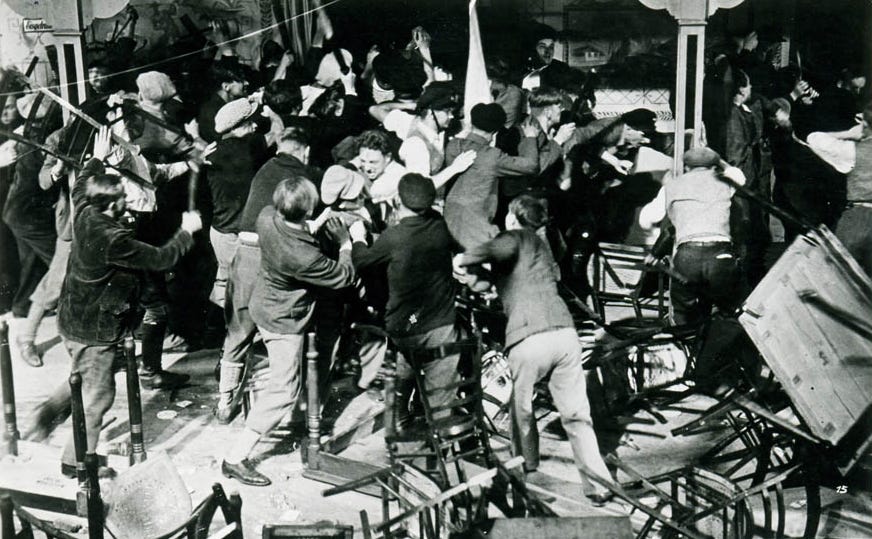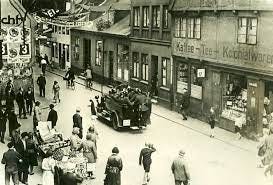The Mirror Trick
Lessons from history: How the Nazis weaponized accusations of violence
In 1932, a young German voter picking up a Nazi pamphlet might have believed the country was in flames because of violent Socialists and Communists. The pamphlets were filled with warnings about left-wing mobs, about thugs trying to tear down order and culture. The message was simple: only the Nazis could restore peace.
But the truth was inverted. More often than not, it was the Nazis who staged the violence, or at least provoked it, then pointed the finger at their political opponents. This tactic—projecting your own aggression onto others—was not a side note of the Nazi rise to power. It was central.
Street Violence as Political Strategy
The Weimar Republic of the 1920s was fragile. Inflation, war reparations, political assassinations, and unemployment had already undermined public trust. Into this storm came the paramilitary wings of the parties carrying out a wave of urban violence: the Communists had the Red Front Fighters’ League (Roter Frontkämpferbund), the Social Democrats had the Reichsbanner, and the Nazis had the Sturmabteilung, better known as the SA or “brownshirts.”
The SA grew into a street army of hundreds of thousands. Their job wasn’t only to defend Nazi rallies—it was to create chaos. They beat up Socialist organizers, stormed meetings, smashed printing presses, and intimidated Jews, Catholics, and anyone they defined as an enemy.
When the inevitable street fights broke out, Nazi propaganda framed the Communists as aggressors. Joseph Goebbels, head of Nazi propaganda, was skilled at taking incidents in which Nazis were the attackers and spinning them as defensive actions against “Red terror.” The narrative was always the same: Germany was under siege, and the Nazis were the shield.
The Altona Bloody Sunday
One of the starkest examples came in July 1932 in the Hamburg district of Altona, a Communist stronghold. Nazis staged a march of thousands of SA men through the neighborhood, knowing it would provoke resistance. Clashes broke out between residents and the brownshirts. Police opened fire, killing 18 people, most of them Communists or bystanders.
The Nazis immediately seized on the bloodshed, claiming it was proof of Communist violence. Hitler demanded that the government crack down harder on the left. Within weeks, Chancellor Franz von Papen used the incident as a pretext to depose the Social Democratic-led government of Prussia, Germany’s largest state. The coup against Prussia’s government was a turning point: it handed the Nazis and their allies control of Germany’s largest police force and put them a step closer to power.
Violence they had deliberately provoked was repackaged as violence they heroically endured.
The Reichstag Fire
The pattern escalated once Hitler became chancellor in January 1933. A month later, the Reichstag, Germany’s parliament building, burned down. A Dutch Communist, Marinus van der Lubbe, was arrested at the scene. The Nazis instantly declared it part of a Communist plot.
Historians still debate whether van der Lubbe acted alone, but there is no doubt about how the Nazis exploited the fire. They used it to pass the Reichstag Fire Decree, suspending civil liberties and allowing detention without trial. Thousands of Communists, Socialists, and trade unionists were rounded up overnight.
Here again, Nazi violence—the systematic destruction of political opposition—was cloaked as defense against left-wing violence. The Communist threat was exaggerated into an existential danger. Once opposition was neutralized, Hitler was free to consolidate total control.
The Propaganda Machine
Nazi messaging drilled the same point relentlessly: Germany faced “Marxist terror.” Newspapers like the Völkischer Beobachter ran lurid headlines about supposed Communist plots, assassinations, and conspiracies. Goebbels’ speeches painted the Nazis as victims of aggression.
Even when Nazis openly engaged in murder, the narrative held. When SA men killed Communist workers, the press called it retaliation. When police arrested leftists, Goebbels spun it as the state defending itself against violent revolution.
The repetition mattered. Ordinary Germans who wanted stability were told, day after day, that the only way to stop chaos was to support the Nazis. They were the party of law and order. By 1933, enough of them believed it.
Why the Mirror Trick Worked
Several factors made the Nazi tactic effective:
Widespread fear of Bolshevism. The Russian Revolution and civil war were fresh in memory. Stories of the Red Terror haunted German politics.
A divided left. Social Democrats and Communists despised each other almost as much as they hated the Nazis. This made it easy for the Nazis to single them out separately as weak and dangerous.
Media control. Nazi newspapers, street posters, and rallies created a feedback loop where their version of events became reality for millions.
Police complicity. Conservative authorities often sympathized with anti-Communist crackdowns, even if they knew the Nazis had sparked the trouble.
By turning every confrontation into proof of “the violent left,” the Nazis made themselves seem like reluctant warriors for peace.
Echoes in History
This is not a uniquely German story. Authoritarian movements often use the same mirror trick: accuse the enemy of the violence you yourself deploy. Stalin did it against “counter-revolutionaries.” McCarthyites did it against supposed Communist infiltrators. Today, similar accusations appear whenever leaders want to discredit dissent or justify harsher security powers.
The logic is simple: violence delegitimizes. If you can pin it on your opponents, you weaken their credibility and strengthen your own claim to authority.
Lessons
The Nazi rise shows how dangerous it is when a society loses the ability to distinguish between the instigator and the victim. Once the frame is set—“they are violent, we are defending ourselves”—facts no longer matter. What matters is who controls the story.
The victims of Nazi violence were not just the political left. Jews, intellectuals, and anyone who resisted were painted as part of the violent conspiracy. By the time Germans realized what had happened, the last avenues for opposition had been closed.
Conclusion
History often looks inevitable in hindsight. But the Nazi takeover was not preordained. It was achieved in part through a propaganda sleight of hand: accusing others of the very violence they inflicted. Altona Bloody Sunday, the Reichstag Fire, the street battles of the SA—all were chapters in the same playbook.




